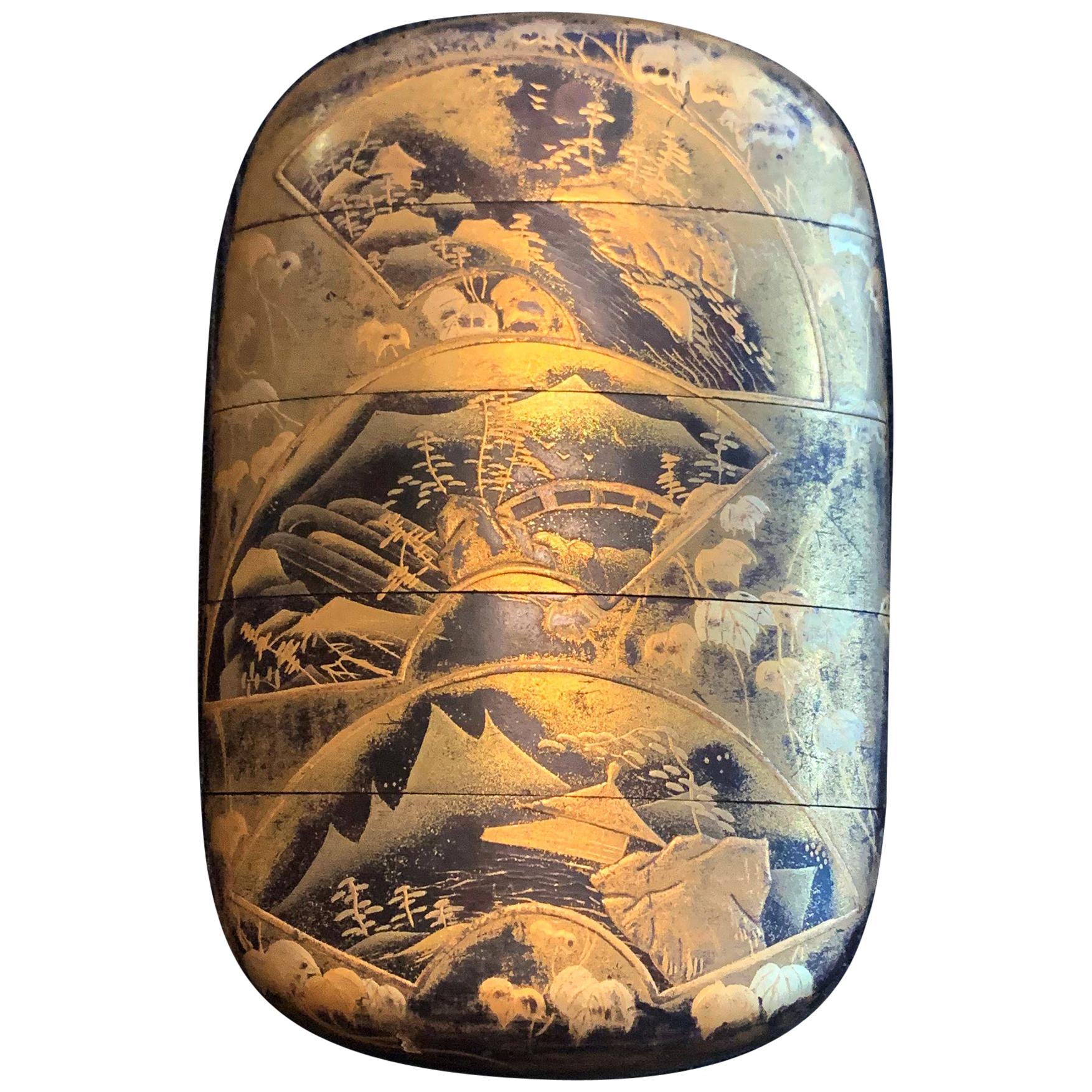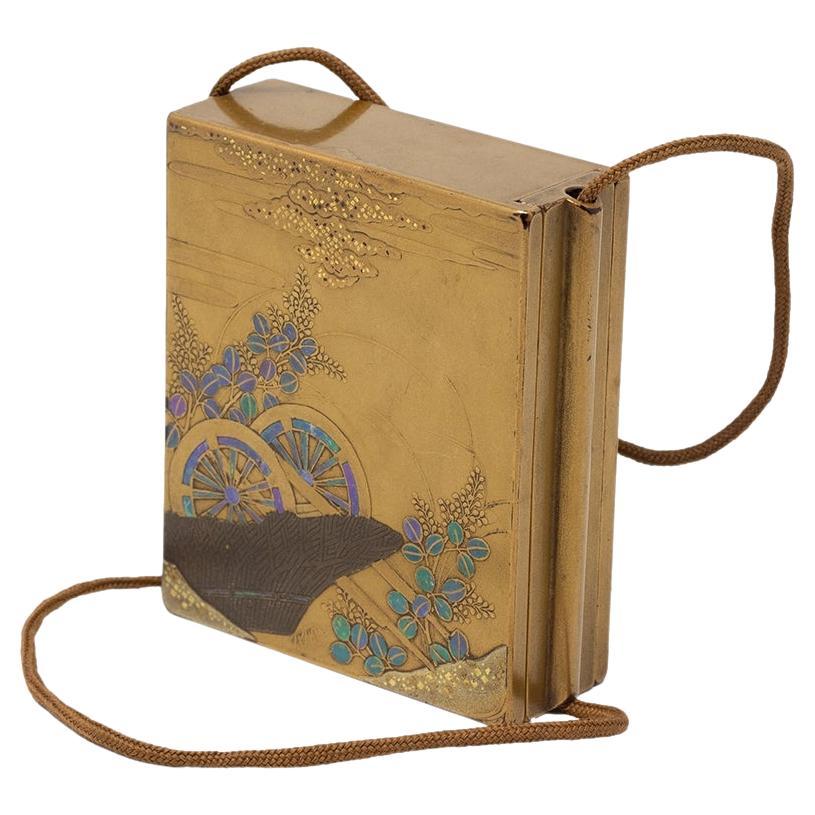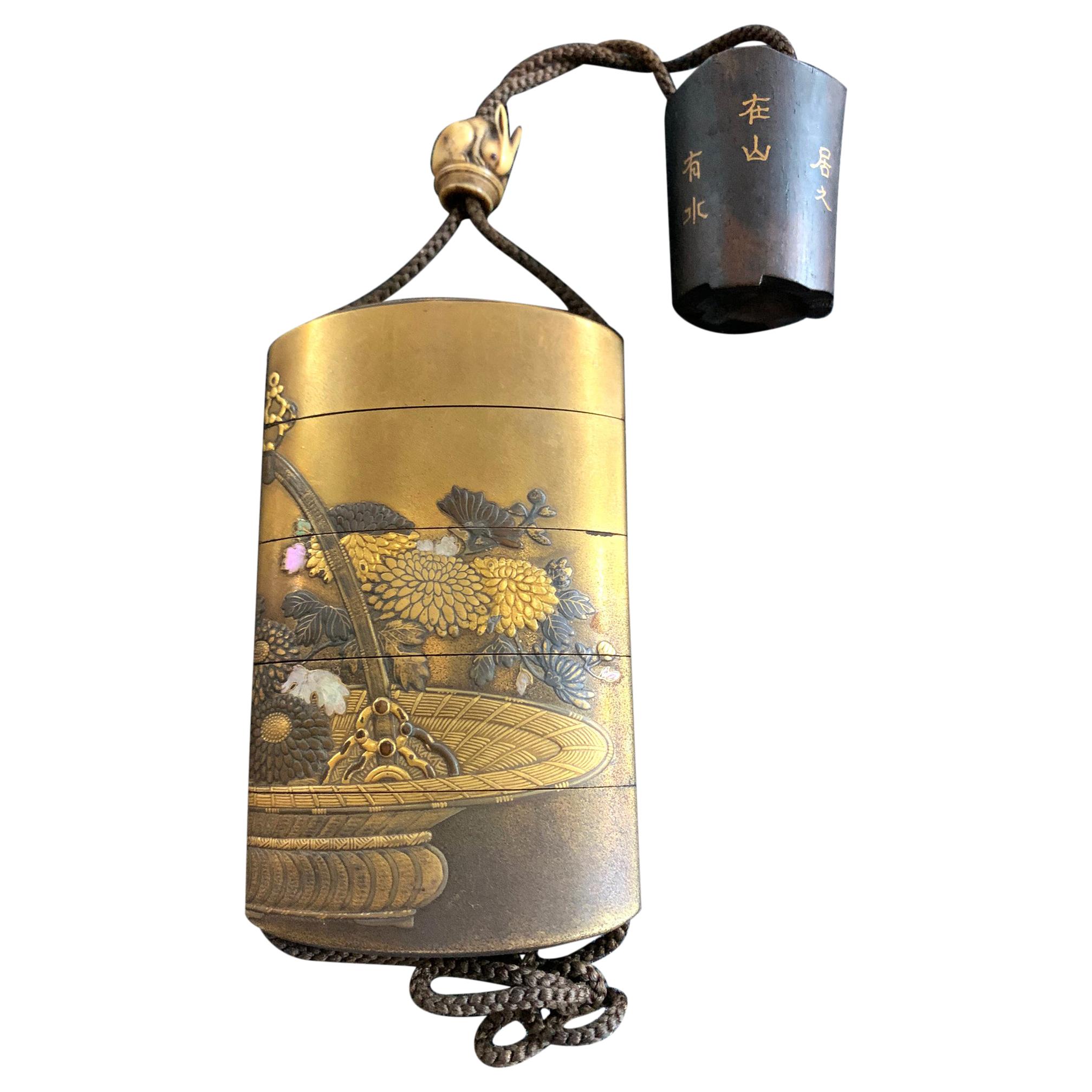Items Similar to A Japanese Lacquer Inro Depicting A Daikokuten With His Hammer
Want more images or videos?
Request additional images or videos from the seller
1 of 7
A Japanese Lacquer Inro Depicting A Daikokuten With His Hammer
About the Item
Japanese lacquer inro depicting a Daikokuten with his hammer watching children, next to a Matsu plant.
Excellent quality decoration with relief details, shine and original patina.
Polychrome wooden netsuke depicting a seated sage with a fan, painted ceramic ojime.
Inro signed Kajikawa with the kao under the base.
Origin: Japan
Period: Edo mid-18th century.
Overall dimensions: 9 x 4.5 x 3 cm.
Netsuke dimensions: 4 x 3 x 2.5 cm.
State of conservation: Very good
- Dimensions:Height: 3.55 in (9 cm)Width: 1.78 in (4.5 cm)Depth: 1.19 in (3 cm)
- Style:Japonisme (In the Style Of)
- Materials and Techniques:Lacquer,Lacquered
- Place of Origin:
- Period:
- Date of Manufacture:Edo period 18th century
- Condition:
- Seller Location:Milano, IT
- Reference Number:1stDibs: LU9162238145482
About the Seller
No Reviews Yet
Vetted Seller
These experienced sellers undergo a comprehensive evaluation by our team of in-house experts.
1stDibs seller since 2023
- ShippingRetrieving quote...Ships From: Milano, Italy
- Return PolicyA return for this item may be initiated within 14 days of delivery.
More From This SellerView All
- A Japanese maki-è lacquer inroLocated in Milano, ITJapanese inro with two compartments, in maki-è lacquer with nashiji decorations and circular reserves depicting flowers and leaves. Coral colored ojime and lacquer manju netsuke. Si...Category
Antique Mid-19th Century Japanese Japonisme Lacquer
MaterialsLacquer
- Kogo box in maki-è lacquer depicting a naturalistic sceneLocated in Milano, ITKogo box in maki-è lacquer, with a domed lid depicting a naturalistic scene. The gold decoration depicts the Japanese pine, known as Matsu, and a typical house with a thatched roof a...Category
Antique Late 19th Century Japanese Japonisme Lacquer
MaterialsLacquer
- A Japanese boxwood netsuke depicting a Dutchman with a childLocated in Milano, ITBoxwood netsuke depicting a Dutchman with a child on his shoulder and a trumpet. Excellent blond patina on the front contrasting with the darker part on the back. Large himotoshi h...Category
Antique Mid-18th Century Japanese Japonisme Antiquities
MaterialsBoxwood
- A Japanese bronze okimono depicting an elephant with two tigersLocated in Milano, ITPatinated bronze okimono depicting an elephant defending itself from the attack of two tigers: one on its back and the other under its paw. Very well worked in the details of the el...Category
Antique Late 19th Century Japanese Japonisme Metalwork
MaterialsBronze
- A Japanese patinated bronze vase depicting a cricketLocated in Milano, ITA slender shape patinated bronze vase depicting a naturalistic scene of a cricket sitting on iris leaves. Signed Joun in relief within an oval reserve. Origin: Japan Period: Meiji ...Category
Antique Late 19th Century Japanese Japonisme Metalwork
MaterialsBronze
- A Japanese wooden okimono depicting a lying horseLocated in Milano, ITWooden okimono depicting a lying horse, finely carved down to the smallest details. The muscles, hooves and mane are rendered with care and artistry, capturing the vitality of the ho...Category
Antique Mid-19th Century Japanese Japonisme Antiquities
MaterialsWood
You May Also Like
- Fine Japanese Lacquered Inro with Inlays by KajikawaLocated in Atlanta, GAA Japanese four-case lacquer inro by a member of Kajikawa family circa 19th century (late Edo to early Meiji period). It depicts a nocturnal scenery of a meandering stream surrounded by bush clovers, where a full moon is reflected on the water. It was masterfully decorated in gold and silver maki-e using a combination of techniques including takamakie, togidashi and kirigane as well as aogai (abalone shell) inlays. The stream was set between the slightly elevated banks, adding to this piece a already strong three-dimensional composition. The interior was decorated in gold nashiji. It was signed on the bottom "Kajikawa Zou" (made by Kajikawa and a pot seal centered with "Ei" in Kanji. In one of the compartment, there is a katakana mark, appears to be a name, possibly the owner. Kajikawa clan was one of the most famous lacquer artisanal family established in the 17th century. Many well known members over the generations produced lacquer art in a wide range of formats, but two third were signed only with the family name such as this one. It is therefore not possible to pinpoint the exact author of this piece. Provenance: This inro was purchased as lot 349 in Christie's New York sale Japanese...Category
Antique 19th Century Japanese Japonisme Lacquer
MaterialsShell, Wood, Lacquer
- Fine Japanese Lacquered Inro by YutokusaiLocated in Atlanta, GAA four-case lacquered Japanese inro by Yutokusai (Gyokkei), a lacquer artist active from 1845-1900 (end of Edo to Meiji period). The slightly round inro features a very intricate design with three unfolded fans on the front and two on the back: each reveals a vignette landscape scenery, likely real places in Japan. Using a combination of hiramaki-e and slight takamaki-e, the artist deftly created the pictures with fine details, rendering the inro as a miniature artwork...Category
Antique 19th Century Japanese Japonisme Lacquer
MaterialsWood, Lacquer
- Rare Japanese Sumi-E Lacquer Inro Yamada Jokasai Edo PeriodLocated in Atlanta, GAA three-case lacquered Inro by Yamada Family circa 18th-19th century Edo period. The inro with slight rounded form is of Kano style and vividly depicts a dragon slithering among the ink clouds on a gold background. Sumi-e togidashi (ink togidashi) technique, in combination with Hiramaki-e, were employed to create the dreamy ambience of this piece. The dragon has a painterly appearance inspired by Chinese ink painting that was often seen on the Japanese folding screens. The back of the Inro was sparsely decorated with the shifting patterns of the darkening clouds with an emphasis on the space intentionally left empty. Jokasai was signed to the base. On the front of the inro there is another miniature signature Hakugyoku Hogen, which is one of names used by Kano Michinobu (1730-1790). The dragon is evidently one of his designs (see reference below). Established by a member of Yamada family in the 17th century, the clan was one of the most prominent lacquer artisanal family for the next 200 years until the end of Edo period in the 19th century. Most members signed their work simply with Jokasai making the identification of the individual artists somewhat impossible. The current Inro on offer, compared to many other pieces by Jokasai, has an uncommon Kano style done in Sumi-e togidashi. Another unusual feature of this piece is that the interiors of the inro was decorated with an interesting gold mosaic inlays (kirigane) on a dark lacquer background, giving it a jewel like quality. For another Inro by Jokasai of a similar style using Sumi-e togidashi but depicts a tiger, see Wrangham collection, no.353, which was offered for sale as lot 256 in Bonham's London Auction: The Edward Wrangham Collection of Japanese Art Part I. 9 Nov 2010. For an ink scroll...Category
Antique 18th Century Japanese Japonisme Lacquer
MaterialsWood, Lacquer
- Japanese Meiji Period Lacquer Six Drawer InroLocated in Newark, EnglandThe Inro is decorated with a gold lacquer base and features mother of pearl shell inlay leaves surounding wheeled cart with foliage. The Inro with a slide action opening which hides ...Category
Antique Late 19th Century Japanese Meiji Lacquer
MaterialsRope, Lacquer
- Antique Japanese Inro by Shigehide Edo PeriodLocated in Atlanta, GAThis exquisite four-case lacquered inro was dated to the latter part of 18th century to early 19th century (Edo period) and made by Shigehide. The opposite sides of the inro together features a lavish flower arrangement in a bamboo basket (ikebana). The detailed craftmanship was a true pleasure to behold. Mostly Takamaki-e (high relief) were used to texturize the delicate petals of the chrysanthemums, on which different shades of gold were used to create contrast. Raden (mother of pearl) shells were also used to highlight some leaves, rendering the piece an interesting balance of color and material. The interior was completed in a mottled gold finish. It was signed Shigehide on the bottom with a Kao. There is a small carved rabbit ojime bead...Category
Antique Late 18th Century Japanese Japonisme Lacquer
MaterialsWood, Lacquer
- Japanese Inro by Koma Koryu Edo PeriodLocated in Atlanta, GAA four-case lacquered inro by Koma Koryu circa 19th century late Edo period. The inro features a pair of Chinese mandarin duck resting under a bundle of blooming irises on the pond. ...Category
Antique 19th Century Japanese Japonisme Lacquer
MaterialsWood, Lacquer
Recently Viewed
View AllMore Ways To Browse
Giant Silver Tray
Black And Gold Lacquer Chinese Miniature Chests
Japanese Ojime Beads
Metal Netsuke
Japanese Meiji Period Silver Kodansu
Chinese Export Black Lacquer With Hand Painted Scene
Jo Nagasaki
Indonesian Dowry Chest
Suzuri Bako
Japanese Negoro
Lacquerware Burmese Tray
Chinese Bridal Cabinet
Inro Cockerel
C T Loo
Burmese Lacquerware Betel Box
Chinese Chippendale Jewelry Box
Chinese Lac Burgaute
Japanese Lacquer Inro Bag





